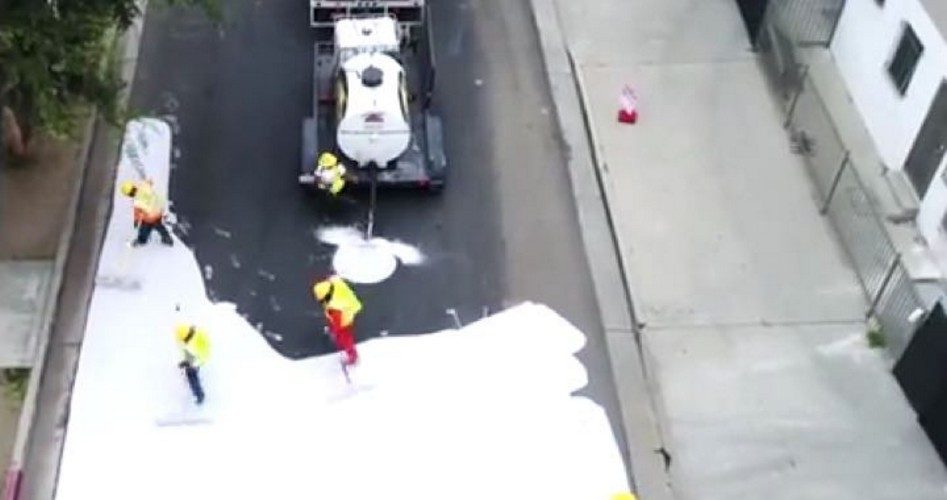
California just keeps getting crazier. When it comes to the most absurd use of taxpayer money, the city of Los Angeles may just win the award. In a move intended to cool down the city and fight the effects of global warming, the city is painting many of its streets with a grayish-white substance known as CoolSeal, which reflects sunlight, in theory making the city cooler.
The cost to taxpayers is a mere $40,000 per mile. With 6,500 miles of road in Los Angeles, that’s a hefty price tag, more than a quarter of a billion dollars. Admittedly, there are no plans to paint all the roads in L.A. — yet. Even so, $40,000 per mile seems a hefty price to pay, especially for something that has to be redone every seven years.
City officials, led by Mayor Eric Garcetti, are hoping that the whiter roadways will reduce the urban heat island (UHI) effect, which can make urban areas much warmer than rural areas.
“It’s awesome. It’s very cool — both literally and figuratively,” observed L.A. Councilman Bob Blumenfield, while watching CoolSeal applied in his district of Canoga Park. “The downside: we won’t be able to fry eggs on the street.”
Does painting streets white work at all? Early results might seem somewhat promising. When CoolSeal was used on the parking lot at the Balboa Sports Complex in Encino, the average surface temperature dropped from 160F to 135-140F in the two years since the application.
But a study conducted by Arizona State University offers a more skeptical take on cool sealing in relation to city planning. Entitled “Unintended Consequences,” the study details some of the possible issues in using surfaces such as CoolSeal.
From the ASU study: “Reflective pavements lead to greater reflected solar radiation, which can be absorbed by surrounding surfaces and subsequently increases their temperatures.” So, while CoolSeal does cool down the surface it is applied to, that doesn’t mean it cools down the atmosphere around it. The paper also points to a 2012 study that claims buildings might actually become warmer due to the reflected energy from light colored pavements.
And there could be adverse health affects as well. The ASU paper points to a possible increase in the intensity of UV radiation to people, which can result in sunburns and even skin cancer. In addition, the whiter surface of the roads may cause a glare problem on sunny days, which are plentiful in Southern California. GuardTop, the California company that manufactures CoolSeal, claims that the grey matte finish of the product does not cause any glare problems.
So there is some scholarly disagreement on whether this road bleaching will have the cooling effect that the Los Angeles city government is hoping for. And $40,000 per mile seems like a high cost for taxpayers to pay for a public works project that may turn out to have deleterious effects on citizens and the environment, especially when Los Angeles has bigger problems to deal with. The LA Times recently referred to the city’s homelessness crisis as a “national disgrace.” The number of homeless people in Los Angeles has risen 49 percent since Garcetti took office in 2013. Up to 8,000 homeless persons live in the Skid Row area alone. Diseases such as tuberculosis, hepatitis, and AIDS are rampant, along with illegal drug use and the accompanying violence.
Of course, city budgets are a complicated thing, especially in a city as large and diverse as Los Angeles. Road maintenance funds cannot automatically be shifted to other areas on a whim. But it seems incongruous to spend so much money on a global-warming boondoggle, while other more important issues are pushed aside.
Climate-change alarmists are constantly haranguing governments to “do something” about global warming, as if only government has any worthwhile answers. But government intervention is rarely a good thing. Whether it’s local, county, state, or federal, government complicates things and adds more layers of confusion to issues.
Much like the layers of white paint that the city of Los Angeles is adding to its streets.
Image: Screenshot of a YouTube video by Insider



